The Lanfair's
patent was awarded on August 13, 1895 under
No. 544,411 and
was assigned to Goodell Brothers Company. It included a design for a hand drill and several important
parts that constituted this drill. It was one of
the most important patents, secured by Goodell Brothers Co.
Some patented parts of the drill were easily adoptable to
other products that the company planned to produce. Herbert D. Lanfair described his invention as follows:
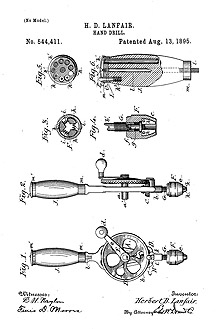 "My invention is an improvement in drills
chiefly for use of woodworking mechanics. It has for its object to provide a drill
mechanism which will easy to operate and multiply the
revolutions of the drill-bit with reference to those of the
crank.
"My invention is an improvement in drills
chiefly for use of woodworking mechanics. It has for its object to provide a drill
mechanism which will easy to operate and multiply the
revolutions of the drill-bit with reference to those of the
crank.
It consists essentially, first, of an
improved chuck for the drill wherein the drill-holding jaws
are separated by springs and held in place by housing
interiorly screw-threaded and adapted to engage a hollow
screw-threaded spindle. It consists, secondly, of an improved
drilling holder or handle for the drill wherein a screw-bolt
running through said holder centrally connects with a
disk-plate at one end and the frame of the drill at the
opposite end, the purpose of said construction being to
strengthen the said handle and thus improve its usefulness."
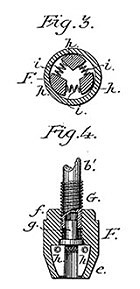 The importance of this patent
was long lasting for the future of the company. The chuck patented here was produced for
over five decades by
Goodell-Pratt Co. and later by Millers Falls Co. and for many more
years after that by many chuck makers in this and other
countries.
The importance of this patent
was long lasting for the future of the company. The chuck patented here was produced for
over five decades by
Goodell-Pratt Co. and later by Millers Falls Co. and for many more
years after that by many chuck makers in this and other
countries.
Another design, a friction plate or gear guide, used to
control pressure on a main gear against a pinion, was used on
many hand drills in Goodell-Pratt's line and continued by Millers
Falls Co. after 1931. Other improvements were used on
dozens of drills, made by both, Goodell-Pratt and Millers Falls
Co.
Interestingly, in the
Hammacher, Schlemmer & Co. catalog, the Goodell's tools were
placed next to Millers Falls Co. tools, but all the Goodell's
tools have a heading - "Goodell's". Millers Falls tools
don't
have any designation for the company and were simply
marked as "Hand Drill", "Breast Drill", etc.
Apparently, Mr.
Pratt had strong and convincing arguments for
Hammacher, Schlemmer & Co.
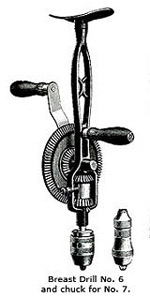 Another important tool shown in the same
catalog is the Breast Drill No. 6 and its variation, No. 7. It
was an important publicity for the Goodells, since it showed a 2-speed
drill with their own speed-changer
design.
Another important tool shown in the same
catalog is the Breast Drill No. 6 and its variation, No. 7. It
was an important publicity for the Goodells, since it showed a 2-speed
drill with their own speed-changer
design.
At the time it was a new design for breast
drills. Up to this point, change of speed in drills was done by removing
the main gear wheel and
placing it in the opposite socket that provided engagement for
the second
teeth layout on the gear-wheel.
This new design was authored by both Goodell brothers. Just like in the past, they joined their talents to do the work for
the company.
The patent was awarded on March 31, 1896, received
No.
557,328 and was assigned to Goodell Brothers
Company. It was another breakthrough patent for Goodell Brothers Company
and later for Goodell-Pratt Company.
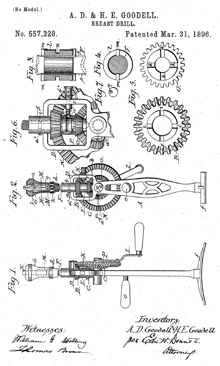 The authors describe their invention as an improvement that...
The authors describe their invention as an improvement that...
"...consists in the main of metallic frame, and adjustable
breast-piece on one end of said frame, a chuck for a bit on the
opposite end of same and between said extremes, a system of
gear-wheels shiftable by means of a clutch to increase or reduce
the motion of the drill with reference to the motion of the
driving-crank and certain circular racks which engage the said
gear-wheels, all of which will be hereinafter fully described
and shown."
The concept of a two speed drill wasn't new, but the use of a
clutch and shifter to manipulate speed change was a different and new approach.
The implementation of this patent served the Goodell Brothers well
in the future development.
One of the tools incorporating the elements of this patent was a Hand Drill No. 5-1/2
- one of the most popular drills of the first half of the 20th
century.
The
Metal Worker, a weekly journal, published
one of the first reviews of the drill in October 31, 1896:
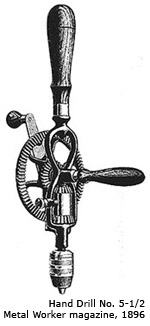 "Goodell Hand Drill No. 5-1/2.
"Goodell Hand Drill No. 5-1/2.
"Goodell Brothers Co., Greenfield
Mass., are offering their No. 5-1/2 hand drill, herewith
shown. The frame is of malleable iron, japanned; the gears
are all cut teeth and the handle is of polished hardwood
with a screw cap.
The chuck is three-jawed with a capacity
from 0 to 3/8 inch, and is provided with a nickel plated
knurled nut. A feature of the drill is the two-speed
device, the speed being quickly changed by aid of the nut at
F and S.
The slow speed, it is remarked, will be found
particularly desirable on large work, a fact that bicycle
repairers will appreciate. No drills (bits) are furnished with the tool."
Interesting circumstances surrounded the release of
this drill. In 1895 Millers Falls Co. released their
second version of a “new” hand drill No. 2. The announcement
came on June 20, 1895 in the Chicago Journal of Commerce and
Metal Industries:
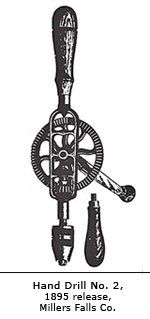 “Millers Falls Company, 93 Reade Street, New
York and Millers Falls, Mass., have made improvement in
their No. 2 hand drill, as here shown.
Among the improvements is the addition of an extra handle,
to be attached when it is desired to use the drill in the
manner of breast drill. The handle is threaded on the end
and is screwed into the frame on the side opposite the
regular handle.
“Millers Falls Company, 93 Reade Street, New
York and Millers Falls, Mass., have made improvement in
their No. 2 hand drill, as here shown.
Among the improvements is the addition of an extra handle,
to be attached when it is desired to use the drill in the
manner of breast drill. The handle is threaded on the end
and is screwed into the frame on the side opposite the
regular handle.
The pattern of the chuck has also been
changed and is now arranged to carry three jaws instead of
two, as heretofore. The advantage gained in holding and
centering the points is emphasized by the company. Similar
chucks are now used on their Nos. 1 and 5 hand drills.”
As I previously noted, Herbert D.
Lanfair, the Goodell brothers' nephew, was employed by Millers Falls
Co. until 1895, when Henry E. Goodell and William M Pratt lured him to join Goodell Brothers
Co. Most likely he was the one, who provided Henry E. with
reliable information on upcoming release of a new drill by
Millers Falls Co. and it is feasible to assume that this
information was one of t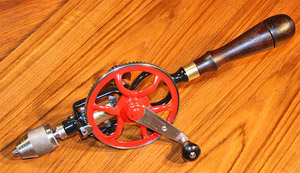 he
motivators for such a rapid development of new tools at Goodell
Brothers Co. The release of hand drill No. 5-1/2 was
likely a competitive response to the Millers Falls Co.'s No.
2 drill release.
he
motivators for such a rapid development of new tools at Goodell
Brothers Co. The release of hand drill No. 5-1/2 was
likely a competitive response to the Millers Falls Co.'s No.
2 drill release.
Today some of the No.
5-1/2 drills receive a facelift and return to the "close to
original" functionality. Although the drill
in the photograph was made about fifteen years after
the first drills of 1896, its basic construction is the same.